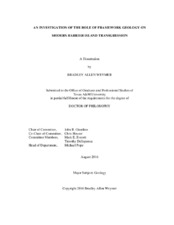| dc.description.abstract | The framework geology controls on modern barrier island transgression and the relationship of these controls to subsurface structure, hydrology, and island geomorphology are not well understood. Recent evidence suggests that alongshore variations in pre-Holocene geology of barrier islands modify nearshore hydrodynamic processes and sediment transport, ultimately affecting how barrier islands will respond to storms and relative sea-level rise. Explorations of Holocene barrier island geology are usually based on cores to supplement bathymetric, onshore/offshore seismic and/or ground-penetrating radar (GPR) surveys. Alternative near-surface geophysical methods including electromagnetic induction (EMI) sensors are increasingly being used for coastal research because they are non-invasive, provide continuous subsurface information across a variety of sub-environments, are capable of characterizing large areas in a short time, and are considerably more cost effective than the abovementioned techniques. This dissertation demonstrates the utility of using EMI methods for mapping large-scale (10^1 – 10^2 km) barrier island framework geology at Padre Island National Seashore (PAIS), Texas, USA. Instrument calibrations and tidal experiments suggest that although hydrology influences EMI signals along the beach, the effect of changing hydrology is not statistically significant over large spatial scales. For the first time, this study shows the importance of statistically modeling EMI spatial data and digital elevation model (DEM) extracted morphometrics to examine the statistical relationships (or lack thereof) between framework geology and geomorphology. A family of fractional autoregressive integrated moving average ARIMA (p,d,q) models demonstrate each spatial data series is most accurately modeled by a single parameter, d, indicating a strong tendency towards long-range dependence (LRD) that suggests self-similarity. Dune height and EMI σa have nearly identical d-values (~ 0.35), which suggests a statistically significant connection between framework geology and dune height at a global scale (100 km). Variations in d at both regional (~30 km) and local (10 km) scales differ by varying degrees, providing further evidence that framework geology controls are more important at the largest spatial scales. By integrating EMI and DEM morphometrics with multivariate analysis and ARIMA modeling, this study offers a robust and novel way for accurately quantifying the entire geological complexity of a barrier island using only three parameters (p,d,q). Moreover, this study shows that EMI sensors are complementary to and offer significant advantages over traditional methods in support of an improved understanding of large-scale barrier island transgression. | en |


